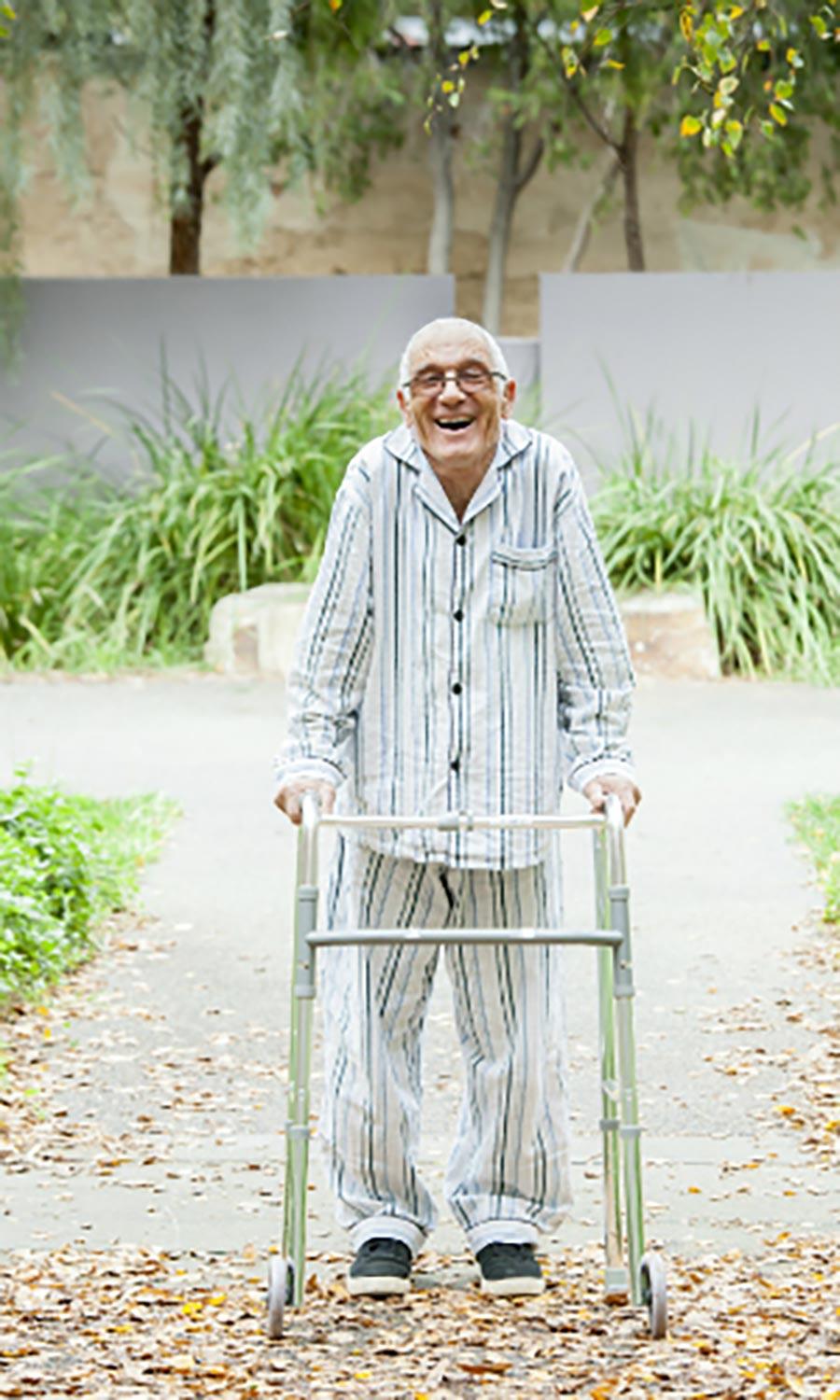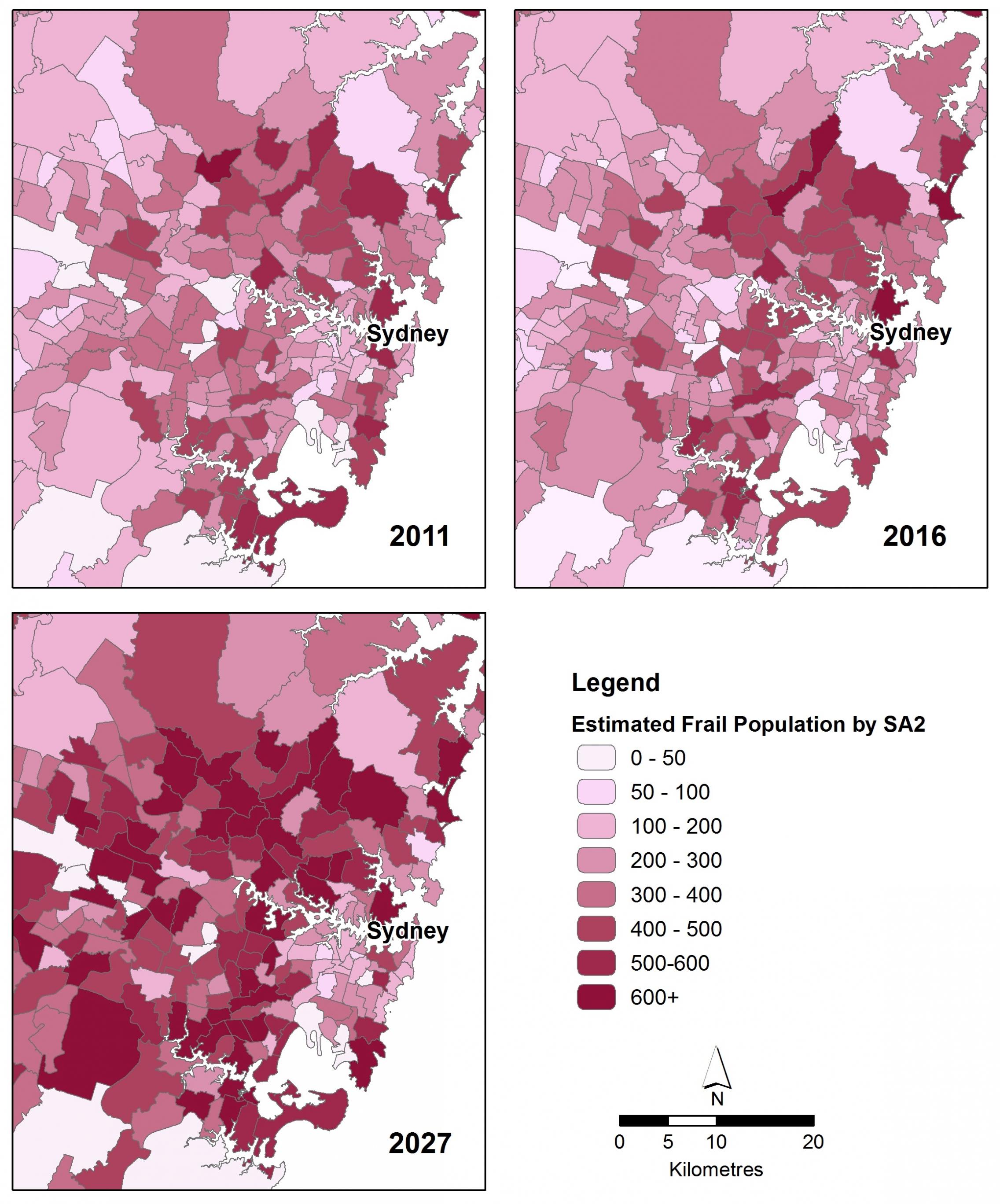Geography of Frailty
Mapping frailty will allow us to visualize the distribution of frailty in our community. Knowing where frailty is will allow us to target health service to where healthcare needs are required. Understanding the neighbourhood and its contribution to frailty will enable us to design new environments that support Healthy Ageing.
-
Inequalities in neighbourhood accessibility: Implications for frailty and healthy ageing
Lead investigators: Dr Danielle Taylor
Healthy ageing is dependent on a person’s ‘functional ability’ which comprises not only an individual’s intrinsic capacity (including health status, mobility and cognition), but also influences of their environment. For individuals to achieve and maintain their highest level of functional ability, the influence of both individual and environmental factors needs to be understood and the impact of negative influences, where possible, minimised.
The creation of “age-friendly environments” has been identified by the World Health Organisation (WHO) as an important contributor to healthy ageing. This research aims to understand the influence of social and environmental factors, as enablers or barriers to healthy ageing. It will have a particular focus on the role geographic access and locational disadvantage plays in facilitating or impeding an individual’s level of functional ability, in addition to socio-economic factors.
Using geographic information technology, the research is developing a spatial socio-environment healthy ageing index incorporating geographic demographic information and accessibility measures of relevance to frailty risk. This index can be used as a planning tool for the equitable and effective provision of services and community resources, ultimately facilitating the development of age-friendly environments.
This work is supported by The Hospital Research Foundation (THRF) mid-career fellowship grant.
Media contact: Dr Danielle Taylor
-
Australia’s current and future frail populations – The frailty web maps
Lead investigators: Dr Helen Barrie and Dr Danielle Taylor
Geographic information about the current and future distribution of Australia’s frail population provides critical information to inform policy, resource allocation and planning initiatives that aim to treat and reverse frailty.The Australian population is ageing rapidly and more Australian’s are at risk of frailty. Frailty is a preventable and treatable condition that reduces the quality of life of many older people.
Dr Danielle Taylor, and Dr Helen Barrie, in conjunction with Professor Renuka Visvanathan, international investigator Dr Olga Theou, Mr Mark Thompson and Mr Jarrod Lange have undertaken research to determine the prevalence and geographic distribution of Australia’s frail and pre-frail population.
This research has led to the development of an interactive Frailty web map and research publication “Geospatial Modelling of the Prevalence and Changing Distribution of Frailty in Australia – 2011 to 2027” (Taylor et al. 2019) that provides insight into the size, distribution and growth of Australia’s frail and pre-frail population.
The research has identified that more than half of the Australian population aged 65 years or more are estimated to be frail or pre-frail, and the geographic distribution of these populations is not uniform. Over coming years Australia's frail and pre-frail populations are expected to grow rapidly. Growth is expected to be fastest in regional, remote and outer metropolitan areas. By 2027, it is estimated that there will be 609,309 frail and 2,248,977 pre-frail people in Australia, if frailty prevalence continues at current levels (Taylor et al, 2019).
Australia is the first country to have and interactive frailty map and is in a unique position to address the growing issue of frailty. Reducing frailty will improve the quality of life of many older Australian’s and enable them to remain independent and living in their own homes, while also reducing the higher utilisation of health services, a characteristic of frailty.
Publications:
- Taylor, D., H. Barrie, J. Lange, M. Thompson, O. Theou and R. Visvanathan (2019) "Geospatial Modelling of Frail and Pre-Frail Estimates for Australia: Mapping Frailty Prevalence - Updated Data to 2032" Experimental Gerontology DOI: https://doi.org/10.1016/j.exger.2019.05.010
Media contact: Dr Helen Barrie and Dr Danielle Taylor
-
Older adults’ perceptions of the built environment and associations with frailty: a feasibility and acceptability study
Lead investigators: PhD candidate Dr Beatriz Martins, Professor Renuka Visvanathan, Dr Helen Ruth Barrie and Dr Joanne Dollard
It is essential to evaluate frail older adults understanding and execution of survey tools to improve data quality and accurate representation in health research. The study tested the feasibility and acceptability of a survey that assesses various measures of functional status in frail older people. The study evaluated recruitment rates; time to complete questionnaires and difficulties encountered; and acceptability by participants. Twenty-five older patients of a post-acute restorative program (residential Transition Care Program) in Adelaide, South Australia were interviewed. Time to complete the overall questionnaire differed between robust, pre-frail and frail participants. Overall, the survey was considered acceptable and feasible, and considerations were taken in regards to regarding length, phrasing and layout. Improving our research tools to better capture older adults’ responses is essential to be more inclusive in older adults’ research.
Publications:
- Arakawa Martins B, Barrie H, Dollard J, Mahajan N, Visvanathan R. Older Adults' Perceptions of the Built Environment and Associations with Frailty: A Feasibility and Acceptability Study. J Frailty Aging. 2018;7(4):268-271. doi: 10.14283/jfa.2018.23
Media contact: Dr Beatriz Martins
-
Physical activity and frailty: Exploring cross-cultural and neighbourhood influences
Lead investigators: PhD candidate Dr Beatriz Martins with supervisors Professor Renuka Visvanathan and Dr Helen Ruth Barrie Barrie and Professor Masafumi Kuzuya (Nagoya University, Japan)

Frailty syndrome, characterized by decreased physiological functions and increased risk for falls, hospitalization and death, is expected to represent a major challenge to communities and health systems around the world, as the population ages. The two best investigated treatment and preventative options remain promoting physical activity behaviours and nutritional supplementation. Promoting physical activity involves understanding the physical and built environment where the older person lives. This research aims to investigate if neighbourhoods built environment characteristics are associated with frailty development, and how this relationship might differ amongst different communities. In Australia, community-dwelling older adults that attend the University for the Third Age will be recruited for a geriatric assessment, evaluation of frailty components and physical activity levels, as well as giving their perceptions about their neighbourhood environment. In Japan, a group of community-college older adults from a cohort established in 2014 will also be investigated for the same parameters.
This work is supported by the Beacon of Enlightenment PhD Scholarship – Nagoya University Joint Award (University of Adelaide).
Media contact: Dr Helen Barrie
-
Built environment
Lead investigators: Beatriz Arakawa Martins, Helen Barrie
The experience of older adults attending hospital services
This study was conducted by our PhD graduate (Dr Beatriz Martins) with 16 geriatric medicine outpatients. The study found that there were elements from the hospital environment that were identified as facilitators and barriers for utilization and these were intrinsically related to the participant’s physical capacity.
Publication:
- Martins BA, Barrie H et. al. A multi-disciplinary exploratory approach of investigating the experience of older adults attending hospital services. HERD 2021; 13(1): 141-163.
Frailty level and the neighbourhood environment
This was a cross sectional study of 114 community dwelling adults and was a project jointly lead by Dr Danielle Taylor (health geographer) and Dr Beatriz Martins (PhD graduate).
The study demonstrated that frail and pre-frail older adults were more likely to live in areas with lower residential density, lower density of road crashes, and higher accessibility than robust participants.
Additionally, a poorer perception of the overall environment, worse land-use mix and accessibility and worse crime safety were associated with frailty and pre-frailty after adjustment for objective covariates of the neighbourhood.
Publications:
- Martins BA, Taylor D et. al. Objective and subjective measures of the neighbourhood environment: associations with frailty level. Arch Gerontol Geriatr 2021l 92: 104257.
- Martins BA, Barrie J et. al. Older adults’ perceptions of the built environment and associations with frailty: a feasibility and acceptability study. J Frailty Aging 2018; 7(4): 268-271.
Media contact: Helen Barrie
-
Walkability perceptions by older adults with differing frailty risk from three different cultures: Nagoya, Hong Kong and Adelaide
Lead investigators: PhD candidate Dr Beatriz Martins with supervisors Professor Renuka Visvanathan and Dr Helen Ruth Barrie, Professor Masafumi Kuzuya (Nagoya University, Japan) and Professor Jean Woo (Hong Kong University)
We hypothesize that neighbourhood environment can play a role into the aging process and development of frailty. The aim of this study was to conduct an exploratory investigation of older adults’ perceptions about their neighbourhood and associations with wellbeing and frailty in Adelaide, Nagoya and Hong Kong. Ninety-one participants from Hong Kong, 39 from Adelaide and 432 from Nagoya will be analysed regarding their frailty status, perceived neighbourhood environmental walkability, physical activity levels and other socio-demographical variables. This research stresses the importance of environmental variables on frailty risk and development of new strategies to mitigate its’ development.
Media contact: Dr Beatriz Martins

